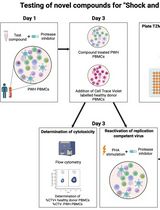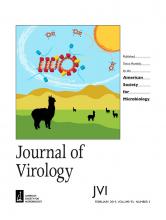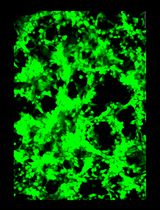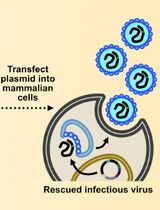- EN - English
- CN - 中文
Image-based Quantification of Direct Cell-to-cell Transmission of Bovine Viral Diarrhea Virus
基于成像量化分析牛病毒性腹泻病毒的细胞间传播
发布: 2019年08月05日第9卷第15期 DOI: 10.21769/BioProtoc.3319 浏览次数: 5219
评审: Vamseedhar RayaproluVaibhav B. ShahShweta Kailasan

相关实验方案

诱导型HIV-1库削减检测(HIVRRA):用于评估外周血单个核细胞中HIV-1潜伏库清除策略毒性与效力的快速敏感方法
Jade Jansen [...] Neeltje A. Kootstra
2025年07月20日 2354 阅读
Abstract
Different viruses rely on direct cell-to-cell transmission to propagate infection within the infected host. Measuring this mode of transmission in cultured cells is often complicated by the contribution of cell free viruses to spread, and the difficulty to distinguish between primary infected cells that produce the virus and neighboring cells that are the target of spreading. Here, we present a protocol to quantify cell-to-cell transmission of the model pestivirus bovine viral diarrhea virus that is based on the co-culture of producer cells that are infected with a reporter virus expressing mCherry and target cells that stably express GFP. Spread of cell-free viruses is blocked by the presence of a neutralizing antibody in the cell culture medium, and cell-associated transmission is unequivocally quantified by numbering cells that are positive for both GFP and mCherry using automated analysis of fluorescence microscopy images.
Keywords: Pestivirus (鼠疫病毒)Background
The spread of virus infections relies both on the dissemination of free virus particles and direct cell-to-cell transmission. In an infected host, cell-associated transmission overcomes multiple barriers imposed to diffusion of free viruses, such as epithelial and mucosal barriers, or antibody neutralization (Sattentau, 2008; Mothes et al., 2010). In vitro, spread of infection in the presence of virus neutralizing antibodies serves as a model to study direct cell-to-cell transmission. Virus spread from a producer cell to a target cell is usually studied in the presence of neutralizing antibodies. Different protocols have been previously devised that measure foci size in non-dividing cell cultures (Barretto and Uprichard, 2014), that use a viral infection-activated split-intein-mediated reporter system to light the expression of fluorescent reporters of contrasting colors in co-cultured producer and target cells (Zhao et al., 2018), or that require immunofluorescence staining of viral antigens in co-cultures where target cells express a fluorescent protein (Yang et al., 2015). In addition, luciferase-based assays have been developed to measure cell-associated spread of HIV in co-cultures of cells expressing an HIV reporter genome and target CD4+ T cells (Zhong et al., 2013; Agosto et al., 2014). We have recently shown that bovine viral diarrhea virus (a pestivirus in the family Flaviviridae) spreads by cell-to-cell transmission in cell culture using an approach that relies on the use of a co-culture of producer cells infected with a reporter bovine viral diarrhea virus expressing mCherry fluorescent protein, and target cells expressing GFP (Merwaiss et al., 2019). In this setup, numbering cells positive for both mCherry and GFP scores virus transmission from producer to target cells. Quantification is performed by automated image analysis of fluorescence microscopy images, and spreading is expressed as the percentage of (mCherry and GFP positive cells)/(GFP positive cells). The protocol provides an unambiguous method to quantify virus spread and has the main advantages of not requiring immunofluorescence staining, and of relying only on the use of any susceptible cell line. In addition, it can be adapted to fully automated image acquisition and analysis, live cell imaging or flow cytometry setups.
Materials and Reagents
- 24-well tissue culture plates (catalog number: BF-TCP011024)
- 35-mm tissue culture plate (catalog number: TCD010035)
- 100 mm tissue culture dish (catalog number: JBF-TCD010100)
- Glass coverslips 12 mm Ø (Marienfeld, catalog number 0111520)
- MDBK cells (ATCC, catalog number: CCL-22)
- MDBK-GFP cells
Note: MDBK cells stably expressing GFP are generated by transduction with a lentivirus carrying a GFP transgene under the control of the CMV promoter. In our hands, the transduction efficiency of MDBK cells is around 5-10% and the population is enriched in GFP expressing cells by fluorescence activated cell sorting (Merwaiss et al., 2019). - ncpBVDV/mCherry-E2 (generated using a reverse genetic system as previously described in Merwaiss et al., 2019)
- Dulbecco’s Modified Eagle Medium (DMEM) with High Glucose (Gibco, catalog number: 12800082)
- Fetal Bovine Serum (PAA, catalog number: A15-101)
- Horse Serum heat inactivated, New Zealand origin (Gibco, catalog number: 26050088)
- Penicillin, Streptomycin (10,000 U/ml) (Gibco, catalog number: 15140122)
- DPBS (Gibco, catalog number: 21600069)
- Trypsin-EDTA 10x (Gibco, catalog number: 15400-054)
- DAPI (Molecular Probes, catalog number: D1306)
- FluoroGuard antifade reagent (Bio-Rad, catalog number: 170-3140)
- Mouse anti BVDV E2 monoclonal antibody (DMAB28412; Creative Diagnostics)
- Mouse anti BVDV E2 polyclonal serum and total IgG fraction (Merwaiss et al., 2019)
- 4% solution of paraformaldehyde [PFA, (Sigma, catalog number: 158127)] in PBS (CSH Protocols, 2006)
- Complete medium (see Recipes)
- Infection medium (see Recipes)
Equipment
- 37 °C, 5% CO2 cell culture incubator (Thermo Scientific Form Series II Water Jacketed, model: 3131)
- Nikon Eclipse 80i Fluorescence microscope equipped with a DS-Qi1Mc camera
Software
- Fiji (Schindelin et al., 2012)
Procedure
文章信息
版权信息
© 2019 The Authors; exclusive licensee Bio-protocol LLC.
如何引用
Merwaiss, F. and Alvarez, D. E. (2019). Image-based Quantification of Direct Cell-to-cell Transmission of Bovine Viral Diarrhea Virus. Bio-protocol 9(15): e3319. DOI: 10.21769/BioProtoc.3319.
分类
微生物学 > 微生物-宿主相互作用 > 病毒
细胞生物学 > 细胞成像 > 荧光
您对这篇实验方法有问题吗?
在此处发布您的问题,我们将邀请本文作者来回答。同时,我们会将您的问题发布到Bio-protocol Exchange,以便寻求社区成员的帮助。
Share
Bluesky
X
Copy link











